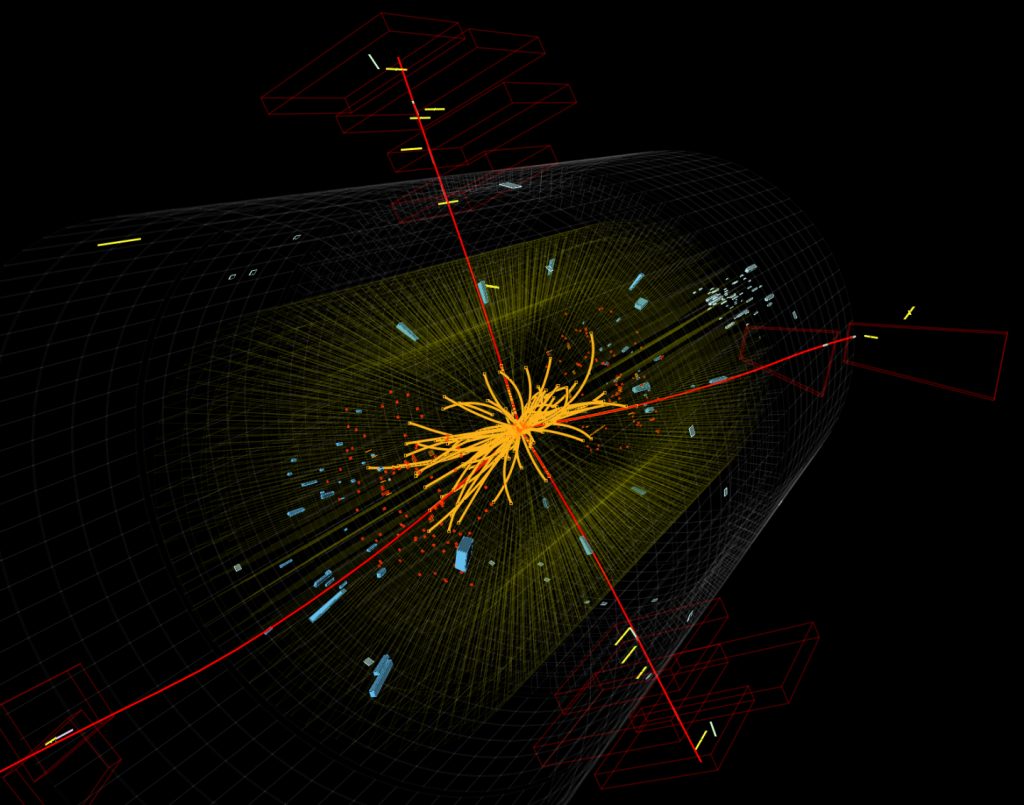The recent breakthrough in research in Higgs Boson popularly known as the God particle has renewed the interest in particle physics. Questions of fundamental science and its application and their Indian connection have been a favorite topic of UPSC. This article will answer all your questions on Higgs Boson
Table of Contents
Why in Higgs-Bososn is in News
Physicists working with the Large Hadron Collider (LHC) particle-smasher at CERN, in Europe, reported that they had detected a Higgs boson decaying into a Z boson particle and a photon. This is a very rare decay process that tells us important things about the Higgs boson as well as about our universe.
What is Higgs Boson
The Higgs boson is the fundamental particle associated with the Higgs field, a field that gives mass to other fundamental particles such as electrons and quarks. A particle’s mass determines how much it resists changing its speed or position when it encounters a force. Particles get their mass by interacting with the Higgs field; they do not have a mass of their own.
The stronger a particle interacts with the Higgs field, the heavier the particle ends up being. Photons, for example, do not interact with this field and therefore have no mass. Yet other elementary particles, including electrons, quarks, and bosons, do interact and hence have a variety of masses.
This mass-giving interaction with the Higgs field is known as the Brout-Englert-Higgs mechanism, proposed by theorists Robert Brout, François Englert, and Peter Higgs.

When and how Higgs Boson is discovered
Scientists confirmed its existence in 2012 through the ATLAS and CMS experiments at the Large Hadron Collider (LHC) at CERN in Switzerland. This discovery led to the 2013 Nobel Prize in Physics being awarded to Higgs and Englert. ATLAS and CMS( Compact Muon Solenoid) are particle detectors at the LHC facility of CERN (the European Organization for Nuclear Research) in Switzerland.
The Higgs boson can’t be “discovered” by finding it somewhere but has to be created in a particle collision. Once created, it transforms – or “decays” – into other particles that can be detected in particle detectors. Physicists look for traces of these particles in data collected by the detectors. The challenge is that these particles are also produced in many other processes, plus the Higgs boson only appears in about one in a billion LHC collisions.
Features of Higgs Boson
In the Standard Model, the Higgs boson is unique: it has zero spin, no electric charge, and no strong force interaction. The spin and parity were measured through angular correlations between the particles it decayed to.
The standard model of particle physics
The Standard Model of Particle Physics is scientists’ current best theory to describe the most basic building blocks of the universe. It explains how particles called quarks (which make up protons and neutrons) and leptons (which include electrons) make up all known matter. It also explains how force-carrying particles, which belong to a broader group of bosons, influence the quarks and leptons.
The Standard Model explains three of the four fundamental forces that govern the universe: electromagnetism, the strong force, and the weak force. Electromagnetism is carried by photons and involves the interaction of electric fields and magnetic fields. The strong force, which is carried by gluons, binds together atomic nuclei to make them stable. The weak force, carried by W and Z bosons, causes nuclear reactions that have powered our Sun and other stars for billions of years. The fourth fundamental force is gravity, which is not adequately explained by the Standard Model.
Significance of Higgs Boson discovery
Discovering the Higgs boson was just the beginning. In the ten years since, physicists have examined how strongly it interacts with other particles, to see if this matches theoretical predictions. Interaction strength can be measured experimentally by looking at Higgs boson production and decay: the heavier a particle the more likely the Higgs boson is to decay into or be produced from it. Interaction with tau leptons was discovered in 2016 and interaction with top and bottom quarks in 2018.
The Higgs boson has, and will continue to have, an impact on our lives, in ways we may not have imagined. It is part of the answer to why we – and everything we interact with – have mass, feeding our natural human curiosity about our universe and how it evolved. In the search for this particle, accelerator, and detector technologies were pushed to the limits, leading to advances in healthcare, aerospace, and more.
The Indian connection
The sub-atomic particle boson is named after Bengali physicist Satyendra Nath Bose whose pioneering work in the field in the early 1920s changed the way particle physics has been studied. It was Bose who actually figured out (in the specific case of photons) how a group of identical photons would behave. He was interested in reproducing, mathematically, Planck’s law of radiation using only quantum mechanical ideas. He employed a technique in this calculation that laid the foundation of quantum statistics. He then sent his paper to Albert Einstein who recognized the value of his calculation and had the paper translated into German and published in the journal Zeitschrift fur Physik. This paper turned out to be a seminal one and the technique used by Bose goes under the name of Bose-Einstein Statistics and the particles such as photons that obey these statistics are called bosons.
UPSC PYQ
Q. Discuss the work of ‘Bose-Einstein Statistics’ done by Prof. Satyendra Nath Bose and show how it revolutionized the field of Physics. (150 Words, 10 Marks) – UPSC MAINS 2018 GS PAPER III. https://ias34.com/wp-content/uploads/2023/06/GENERAL-STUDIES-PAPER-III.pdf